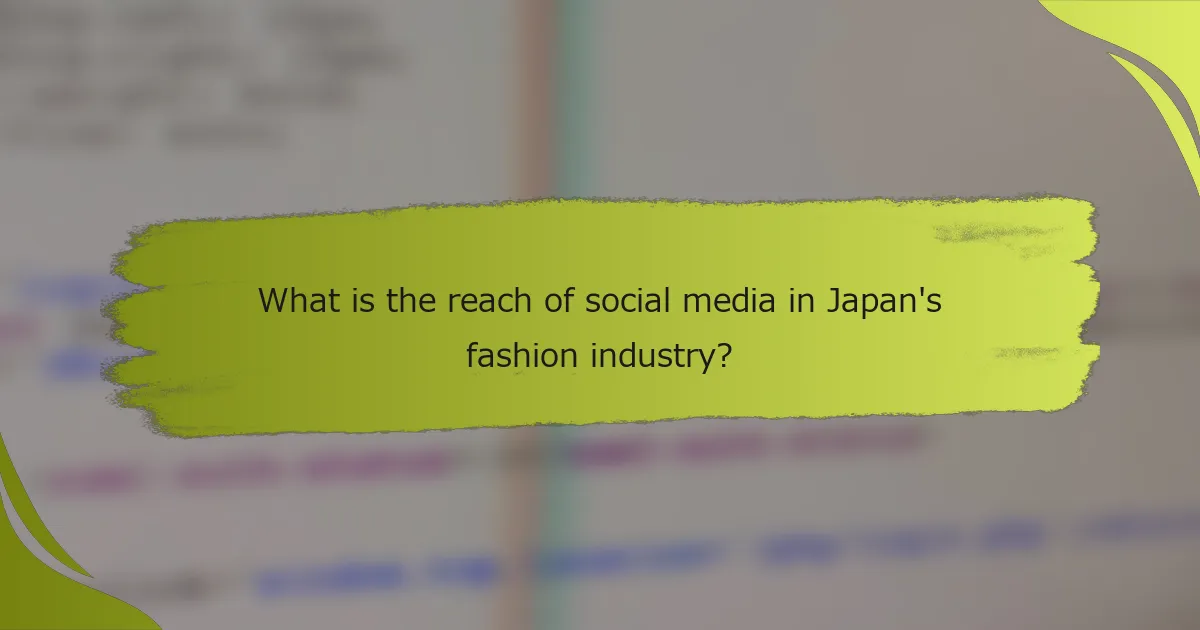ソーシャルメディアは、日本のファッションアイコンのプロモーションにおいて重要な役割を果たしており、彼らの視認性とリーチを向上させています。InstagramやTwitterなどのプラットフォームを通じて、これらのアイコンは独自のスタイルやトレンドを世界中のオーディエンスに発信し、消費者との直接的なエンゲージメントを促進しています。
![]()
How does social media promote Japanese fashion icons?
Social media plays a crucial role in promoting Japanese fashion icons by enhancing their visibility and reach. Platforms like Instagram and Twitter allow these icons to connect with a global audience, showcasing their unique styles and trends.
Influencer collaborations
Collaborating with influencers is a powerful strategy for Japanese fashion icons to expand their brand presence. By partnering with well-known figures, they can tap into established audiences, gaining credibility and visibility. For example, a fashion icon might collaborate with a popular beauty influencer to create a limited-edition clothing line, attracting both fashion and beauty enthusiasts.
These collaborations often lead to co-branded content, which can significantly amplify engagement. Icons should choose influencers whose aesthetics align with their brand to ensure authenticity and resonance with their target audience.
Targeted advertising
Targeted advertising on social media platforms allows Japanese fashion icons to reach specific demographics effectively. By utilizing data analytics, they can tailor ads to particular age groups, interests, and locations, ensuring that their promotions are seen by potential customers. For instance, a campaign targeting young adults in urban areas may focus on streetwear styles that resonate with that demographic.
Investing in targeted ads can yield high returns, especially when combined with visually appealing content. Icons should regularly analyze ad performance to refine their strategies and maximize engagement.
Engagement with fans
Engaging directly with fans is essential for Japanese fashion icons to build a loyal community. Responding to comments, hosting Q&A sessions, and sharing behind-the-scenes content fosters a sense of connection and authenticity. This interaction not only strengthens brand loyalty but also encourages fans to share content, further expanding reach.
Icons should prioritize consistent engagement, as it can lead to organic growth and increased visibility. Regularly updating followers with new collections or personal insights can keep the audience invested and excited.
Content sharing strategies
Effective content sharing strategies are vital for Japanese fashion icons to maintain visibility on social media. Utilizing a mix of formats, such as photos, videos, and stories, can keep the audience engaged and encourage sharing. For instance, posting styling tips or outfit inspirations can prompt followers to share their interpretations, amplifying the icon’s reach.
Icons should also consider user-generated content, encouraging fans to share their looks featuring the brand. This not only provides authentic promotion but also creates a sense of community around the brand. Regularly analyzing which types of content perform best can help refine future strategies for maximum impact.

What is the reach of social media in Japan’s fashion industry?
Social media has a significant reach in Japan’s fashion industry, serving as a vital platform for brands and influencers to connect with consumers. With millions of active users, these platforms shape trends, drive sales, and enhance brand visibility across the market.
Demographics of users
The demographics of social media users in Japan reveal a diverse audience, with a strong presence among younger generations. Approximately 70% of users are under 40 years old, making platforms like Instagram and Twitter particularly effective for targeting this age group.
Gender distribution is relatively balanced, though some platforms may skew slightly towards one gender. For instance, fashion-related content often attracts more female users, while gaming and tech content may appeal more to males.
Platform popularity
In Japan, Instagram and Twitter are the most popular social media platforms for fashion promotion. Instagram, with its visual-centric approach, allows brands to showcase their products effectively, while Twitter facilitates real-time engagement and trend discussions.
Other platforms like TikTok are gaining traction, especially among younger audiences, making it essential for brands to diversify their social media strategies to include these emerging channels.
Global influence
Japan’s fashion industry is increasingly influenced by global trends, with social media acting as a bridge between local and international styles. Japanese fashion icons often draw inspiration from Western trends, which they adapt to fit local tastes.
Conversely, Japanese fashion is also gaining global recognition through social media, with influencers and brands showcasing unique styles that resonate internationally. This reciprocal influence highlights the importance of a strong social media presence for brands aiming to reach a broader audience.

What impact does social media have on Japanese fashion trends?
Social media significantly influences Japanese fashion trends by enabling rapid dissemination of styles and fostering direct engagement between brands and consumers. Platforms like Instagram and Twitter allow fashion icons to showcase their looks, which can quickly become popular among followers and beyond.
Real-time trend analysis
Social media provides real-time insights into emerging fashion trends, allowing brands and influencers to track what styles are gaining traction. By monitoring hashtags and engagement metrics, they can identify popular items and adjust their offerings accordingly. This immediacy helps brands stay relevant in a fast-paced market.
For example, a sudden spike in posts featuring a specific clothing item can prompt brands to produce similar styles, ensuring they meet consumer demand while trends are still hot.
Consumer behavior shifts
Social media has shifted consumer behavior by encouraging more spontaneous purchases and fostering a culture of immediacy. Users often buy items they see on their feeds, influenced by the visual appeal and endorsements from fashion icons. This shift has led to a rise in fast fashion, where brands quickly produce trendy items to capitalize on fleeting interests.
Additionally, consumers are increasingly seeking authenticity and relatability from influencers, which affects their purchasing decisions. Brands that collaborate with genuine influencers tend to see higher engagement and sales.
Brand visibility
Social media enhances brand visibility by allowing fashion labels to reach a broader audience without the need for traditional advertising. Engaging content, such as styling tips or behind-the-scenes looks, can attract followers and create a loyal customer base. Brands that actively participate in conversations on social media often enjoy increased recognition and customer loyalty.
Moreover, collaborations with popular influencers can significantly boost a brand’s profile. When a fashion icon showcases a brand’s products, it can lead to a surge in interest and sales, especially among their dedicated followers.
![]()
How do Japanese fashion icons leverage social media?
Japanese fashion icons effectively use social media to enhance their visibility and connect with audiences. By showcasing their unique styles and engaging with followers, they build a strong personal brand that resonates with fans and potential customers.
Personal branding techniques
Personal branding for Japanese fashion icons involves curating a distinct online persona that reflects their style and values. This can include consistent visual aesthetics, unique fashion choices, and a recognizable voice in their posts. Icons often use specific color palettes and themes to create a cohesive look across their profiles.
Additionally, they may collaborate with brands that align with their image, further solidifying their brand identity. Engaging storytelling about their fashion journey or inspirations also helps to deepen their connection with followers.
Storytelling through posts
Storytelling is a powerful tool for Japanese fashion icons on social media. By sharing personal anecdotes, behind-the-scenes glimpses, and the evolution of their style, they create a narrative that captivates their audience. This approach fosters a sense of authenticity and relatability, making followers feel more connected.
Icons often use captions to elaborate on their outfits, detailing the inspiration behind their looks or the significance of certain pieces. This not only enhances engagement but also encourages followers to share their own stories, creating a community around their brand.
Utilizing user-generated content
User-generated content (UGC) is a valuable asset for Japanese fashion icons. By encouraging followers to share their interpretations of their styles, icons can showcase a diverse range of fashion expressions. This not only builds community but also provides social proof of their influence.
Icons often run campaigns or challenges that invite fans to post their outfits using specific hashtags. This strategy not only increases engagement but also expands their reach as followers share content with their networks, amplifying the icon’s visibility across social media platforms.

What are the key platforms for fashion promotion in Japan?
The primary platforms for fashion promotion in Japan include Instagram, TikTok, and Twitter. Each platform offers unique features that cater to different aspects of fashion marketing, from visual storytelling to real-time engagement.
Instagram’s visual appeal
Instagram is a leading platform for fashion promotion in Japan due to its strong visual focus. Brands and influencers showcase their latest collections through high-quality images and videos, creating an engaging aesthetic that attracts followers.
Utilizing features like Stories and Reels, fashion icons can share behind-the-scenes content and styling tips, fostering a deeper connection with their audience. It’s essential to maintain a consistent visual theme to enhance brand identity.
TikTok’s viral potential
TikTok has rapidly gained popularity in Japan, offering a unique opportunity for fashion promotion through short, engaging videos. The platform’s algorithm favors creative content, which can lead to viral trends that significantly boost brand visibility.
Fashion brands can leverage challenges and hashtags to encourage user-generated content, enhancing community engagement. Collaborating with popular TikTok creators can amplify reach and attract younger audiences who are increasingly influential in fashion trends.
Twitter for real-time updates
Twitter serves as a vital platform for real-time updates and direct communication with fans in the Japanese fashion scene. It allows brands to share news, launch announcements, and engage in conversations with their audience instantly.
Using trending hashtags can help fashion brands tap into broader discussions and increase their visibility. However, it’s crucial to balance promotional content with authentic interactions to maintain a loyal following.

What criteria should brands consider for social media strategy?
Brands should focus on understanding their target audience, selecting appropriate content types, and measuring engagement to develop an effective social media strategy. These elements are crucial for maximizing reach and impact, especially in the competitive landscape of Japanese fashion.
Target audience analysis
Understanding the target audience is essential for any social media strategy. Brands should identify demographics such as age, gender, and interests, which can vary significantly in the Japanese market. For instance, younger consumers may prefer platforms like Instagram, while older demographics might engage more on Facebook.
Utilizing tools like surveys or social media analytics can provide insights into audience preferences and behaviors. Brands should also consider cultural trends and local fashion influences that resonate with their audience, ensuring that their messaging aligns with consumer values.
Content type selection
Choosing the right content type is vital for engaging the audience effectively. Brands can utilize a mix of visuals, videos, and interactive posts to capture attention. In Japan, high-quality images and videos showcasing fashion items in real-life scenarios tend to perform well.
Additionally, incorporating user-generated content can enhance authenticity and foster community engagement. Brands should experiment with different formats, such as live streams or stories, to see what resonates best with their audience and adjust their strategy accordingly.